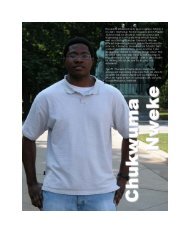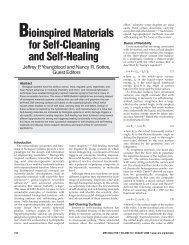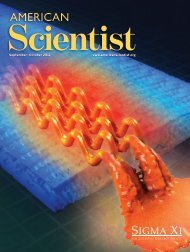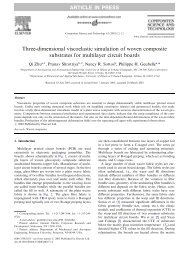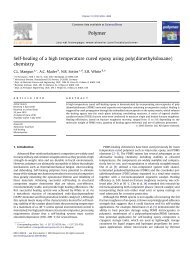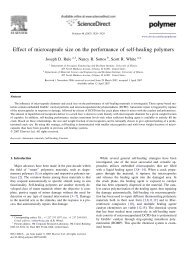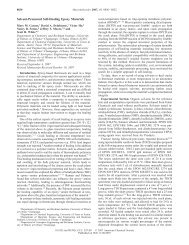Micro- and Nanoscale Deformation Measurement of Surface and ...
Micro- and Nanoscale Deformation Measurement of Surface and ...
Micro- and Nanoscale Deformation Measurement of Surface and ...
You also want an ePaper? Increase the reach of your titles
YUMPU automatically turns print PDFs into web optimized ePapers that Google loves.
52 Exp Mech (2007) 47: 51–62<br />
correlation is a computer-based process to obtain two<br />
dimensional full-field displacement information by<br />
recording the motion <strong>of</strong> a speckle pattern on a specimen<br />
surface (Fig. 1) before <strong>and</strong> after deformation [2–5].<br />
Assuming a locally homogeneous deformation over a<br />
small subset <strong>of</strong> the specimen, the deformed coordinates<br />
(x q , y q ) <strong>of</strong> a material point q in the neighborhood<br />
<strong>of</strong> a point p, at undeformed location (x p , y p ), are<br />
given by<br />
x 0 q ¼ x q þ u p þ @u p<br />
@ x<br />
y 0 q ¼ y q þ v p þ @v p<br />
@ y<br />
Dx q þ @u p<br />
@ y<br />
Dy q ;<br />
Dy q þ @v p<br />
@ x<br />
Dx q ; ð1Þ<br />
where u p <strong>and</strong> v p are the x <strong>and</strong> y components <strong>of</strong> the<br />
displacement vector <strong>of</strong> point p, respectively, x q <strong>and</strong> y q<br />
are the undeformed coordinates <strong>of</strong> point q, Dx q ¼<br />
x q x p <strong>and</strong> Dy q ¼ y q y p .<br />
The displacement <strong>of</strong> a point p is found by either<br />
minimizing a least-square correlation coefficient, or<br />
maximizing a cross-correlation coefficient, <strong>of</strong> the<br />
grayscale intensity value before <strong>and</strong> after deformation,<br />
over a small locally homogeneous square subset S<br />
centered around p [4]. Since the grayscale intensity <strong>of</strong><br />
a point is assumed to be invariant with deformation,<br />
the correlation depends on the original position <strong>of</strong><br />
point p <strong>and</strong> the parameters describing its deformation,<br />
i.e., vector ! <br />
<br />
V ¼ u; v; @u<br />
@x ; @v<br />
@y ; @u @v<br />
@y<br />
; <strong>and</strong><br />
@x<br />
, the unknown<br />
deformation. Changes introduced to the grayscale<br />
intensity <strong>of</strong> the pattern, such as fluctuations <strong>of</strong> the<br />
light source, will affect the accuracy <strong>of</strong> the correlation.<br />
During the minimization process to find the unknown<br />
vector ! V , interpolation between pixels produces subpixel<br />
accuracy in the correlated displacement field <strong>of</strong><br />
about one-tenth <strong>of</strong> a pixel [6]. The interpolation errors<br />
associated with the correlation minimization scheme<br />
will also influence the measurement accuracy.<br />
DIC is an attractive technique for use over multiple<br />
length scales since the method does not possess an<br />
inherent length scale. The accuracy <strong>of</strong> the correlation<br />
between recorded images depends upon the quality <strong>of</strong><br />
the image speckle pattern <strong>and</strong> the resolution <strong>of</strong> the<br />
imaging system. Physical units <strong>of</strong> displacement are<br />
obtained by multiplying the pixel-based measurements<br />
<strong>of</strong> DIC by the image resolution in pixels/unit length.<br />
The ability to perform digital image correlations on a<br />
particular pattern is highly dependent on the refinement,<br />
distribution, <strong>and</strong> r<strong>and</strong>omness <strong>of</strong> the speckle<br />
relative to the pixel size in the image, as well as the<br />
dimensions <strong>of</strong> the subset used in the correlation. While<br />
there are no well-defined guidelines on the optimization<br />
<strong>of</strong> the imaged speckle size relative to the pixel<br />
Fig. 1 Speckle patterns tailored for the specific magnification<br />
required. (a) A pattern created by a low-quality airbrush (Badger<br />
250), (b) a pattern created by a higher-quality airbrush (Iwata<br />
Custom <strong>Micro</strong>n B) <strong>and</strong> (c) a pattern created by fluorescent<br />
nanoparticle surface deposition are shown at similar magnifications<br />
size, a pattern can be qualitatively described by the<br />
image intensity pr<strong>of</strong>ile, where the number <strong>of</strong> pixels at a<br />
given grayscale intensity value ranging from 0 to 255 is<br />
plotted against that intensity value. Unacceptable<br />
SEM





